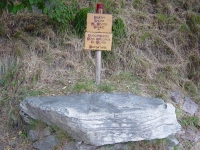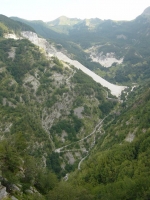Map
The legend of Saint Viano

The place where it makes worship in San Viano, is Mount Tambura. Among its crags and cliffs there is a small shrine carved into the rock, where the saint lived and, in the vicinity of which sprout still called "cabbage of San Viviano". Not far from the cave are the signs of devotion of the saint: the imprint of the knee and one foot left imprinted in the stone of marble. In addition, there are three jets of water that miraculously flowed from the rock in which San Viano would hold three fingers.
Many people still find themselves in San Viano a benevolent protector and use him to gain immunity from dangerous work in the quarries of marble, or to be protected against lightning.

His life is shrouded in mystery. It believes that San Viano was the source of Modena and Reggio Emilia, or that he had passed the Apennines to escape persecution of his wife. Then came On the Castiglione, had met with San Pellegrino and was then continued up to the Apuan Alps, where he found work as an apprentice at a settler of Castagnora under the cave of "Prunelli". It was a very humble man and he had physical deformities that made it awkward and ridiculous. But he was patient and never gets angry.
The shepherds of the place could not understand his way of life and boys were often bored and mocked him, sometimes even throwing stones, but he did not take them smiled and encouraging them to go meet. San Viano loved nature in all its beauty, especially the peaks of grandeur and Apuane not complained that the earth was so demanding and stingy; performed his humble farm work with deep piety, he cultivated the land and the animals cared considering creatures sacred.
Like St. Francis of Assisi, called, considered, brothers plants and animals, and birds reciprocated by going around him, singing and resting on his shoulders, while he was busy at the plow. They often threw the precious seed of wheat, taking the reproaches of the shepherds, but San Viano little they cared, and continued to sing Undaunted, combining his singing, to that of birds. Each year, God blessed the labors of the saint, making the abundant harvest and offsetting in this way, what had been given in the meal to the birds.
After many years of hard work, San Viano felt the need to raise more intensely the spirit to God, and wished to live in solitude, so he went away from Castagnora and climbed up the steep flanks of the Mount Tambura and retired to live in a cave. The place was harsh and inhospitable, food and water scarce. San Viano then recited a "Pater Noster", and prayed whole-hearted. The earth did sprout wild cabbage, bitter taste, which the Holy food even in winter, when snow prevented the exit from his cave. During the hot and arid summer months, when the water was difficult to find, San Viano, one day, after having prayed, laid three fingers on the rock from which flowed three jets of water. It was in that cave that the Saint died and his body was found after many years.
Of course there are variations to the legend about the life of San Viano. In some of these, San Viano is simply a traveler coming from Emilia, who retired to live on Apuane. The shepherds of the place of not seeing well, not him in sympathy, and the stones that tiravano miraculously transformed it into bread. Little by little, then the local people began to appreciate the moral virtues and good wishes.
Subsequently, around the figure of the saint were born too popular local legends, including two they offer particularly significant. The death of San Viano, The heavy door.